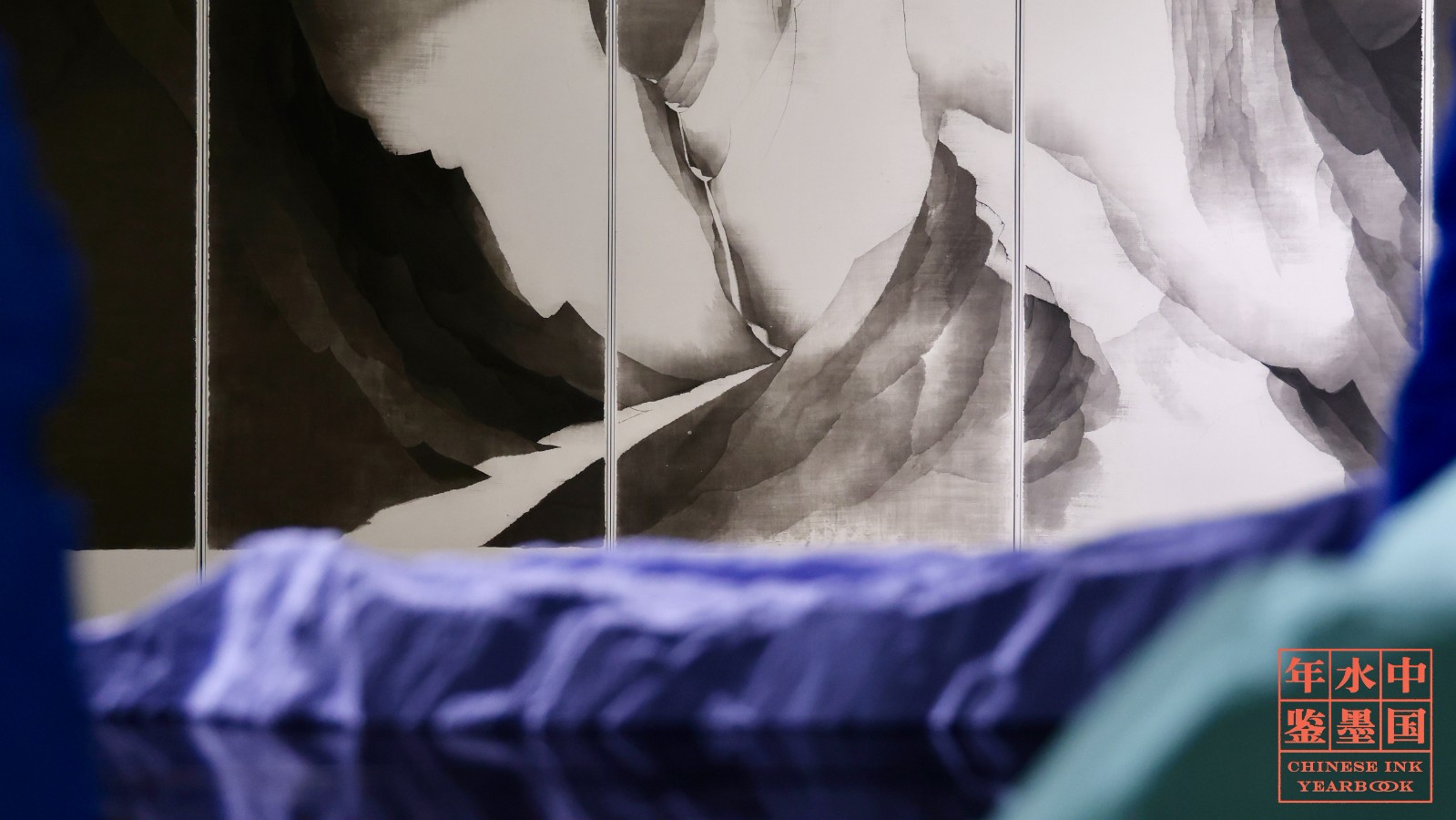 Two terms coined from the literati tradition of Chinese ink art heritage, lying tour, and leaning on parapet, appear in an exhibition titled “The Mountains of the Endless - 2021 Chinese Ink Yearbook”. Opened at the New Everbright Center · An Art Museum in Beijing, this exhibition tries to show the latest development of ink art in contemporary China by archiving and researching. Compared with a few years ago, this kind of archiving and researching of Chinese ink painting is more important today. This importance partially lies on the escalation of tension in political-economic field as well as the divergent stance occurs in the field of art between US and China. "Ink Art: Past as Present in Contemporary China," a 2013 exhibition hosted in the Metropolitan Museum of Art in New York, is in some ways incepts a hidden encounter over Chinese Ink Art.
Two terms coined from the literati tradition of Chinese ink art heritage, lying tour, and leaning on parapet, appear in an exhibition titled “The Mountains of the Endless - 2021 Chinese Ink Yearbook”. Opened at the New Everbright Center · An Art Museum in Beijing, this exhibition tries to show the latest development of ink art in contemporary China by archiving and researching. Compared with a few years ago, this kind of archiving and researching of Chinese ink painting is more important today. This importance partially lies on the escalation of tension in political-economic field as well as the divergent stance occurs in the field of art between US and China. "Ink Art: Past as Present in Contemporary China," a 2013 exhibition hosted in the Metropolitan Museum of Art in New York, is in some ways incepts a hidden encounter over Chinese Ink Art.
 Maxwell K. Hearn, the curator of the MET exhibition, studied with Wen C. Fong (1930-2018), and established extensive contacts with Chinese intellectuals and collectors of Chinese painting and calligraphy, such as Wang Jiqian and Lin Yutang who had settled in New York since the 1950s and 1960s. This collection and research of traditional Chinese literati painting and calligraphy led by Wen Fong has opened the understanding and collection of Chinese ink art in the American cultural-intellectual community. Wen Fong is also a famous scholar of Chinese ink art and has written many books. On the other hand, Maxwell K. Hearn, the curator of the exhibition in 2013, chose a more contemporary perspective in the selection of contemporary ink artists and their works. This contemporary perspective, however, is drastically different from the taste and style of traditional literati ink painting in many aspects. This choice thus objectively produces a Western perspective of ink art. As to the reason why Maxwell K. Hearn chooses this stance in the works of the exhibition, and whether this choice is in his intention, we do not learn from his numerous interviews about the exhibition, but a more realistic and urgent question has been merged, that is, how the contemporary ink painting, as a relatively independent section of art, should be.
Maxwell K. Hearn, the curator of the MET exhibition, studied with Wen C. Fong (1930-2018), and established extensive contacts with Chinese intellectuals and collectors of Chinese painting and calligraphy, such as Wang Jiqian and Lin Yutang who had settled in New York since the 1950s and 1960s. This collection and research of traditional Chinese literati painting and calligraphy led by Wen Fong has opened the understanding and collection of Chinese ink art in the American cultural-intellectual community. Wen Fong is also a famous scholar of Chinese ink art and has written many books. On the other hand, Maxwell K. Hearn, the curator of the exhibition in 2013, chose a more contemporary perspective in the selection of contemporary ink artists and their works. This contemporary perspective, however, is drastically different from the taste and style of traditional literati ink painting in many aspects. This choice thus objectively produces a Western perspective of ink art. As to the reason why Maxwell K. Hearn chooses this stance in the works of the exhibition, and whether this choice is in his intention, we do not learn from his numerous interviews about the exhibition, but a more realistic and urgent question has been merged, that is, how the contemporary ink painting, as a relatively independent section of art, should be.
Regarding this exhibition, Jia Fangzhou comments, "From this (selection of works), we can see that their understanding and value orientation of traditional Chinese ink art is not advancing and reforming in the sense of techniques, but in how to transform ink art into a contemporary pattern. Of the 35 selected artists, only a small percentage really work on the ink as a traditional form of art". Jia Fangzhou’s comments reassert that the most reputative museum and curator in the West interpret and select Chinese contemporary ink painting from the perspective of, and a part within, contemporary art which is essentially a western initiated idea; rather than contemporary ink art as a piece within Chinese art spectrum, as we usually perceived. In other words, the ink artists chosen by the west for the feature of being contemporary rather than being ink. It leads to a question that does ink art contains enough uniqueness and artistic value to be an independent section of art?
The theorist Yin Shuangxi believes that the uniqueness of Chinese ink art lies not only in the uniqueness of its media and materials, but also in the fact that it is an alternative perspective of observation and appreciation from that of the West. Contemporary ink painting can be used as the carrier of artists' subjective experience. The "Clear mind thus watch the Dao" in traditional Chinese ink art sufficiently obtains the function of accommodating contemporary experience and inclusiveness toward other cultures. The Chinese ink art has the unique possibility to express the subjectiveness of contemporary people. Yin Shuangxi, Luo Shiping, Huang Zhuan, Fan Dian, and other domestic theorists as the main body think that the form and material of ink art contain unique values, as do in both the traditional literati context and in the contemporary context. International scholars, such as Martin J. Powers, Maxwell K. Hearn, Wu Hong, John Clark and others tend to treat traditional ink art and contemporary ink art separately. They also emphasize the uncertainty and multi-dimensional dilemma of contemporary ink art in the stage of international art discourse dominated by western art concepts.
It is under this background of what should be the future of contemporary ink art, the exhibition "The Mountains of the Endless", with Professor Zhao Li, Vice Dean of the School of Art Administration and Education at CAFA, as the curator, represents the perspective and orientation of the Central Academy of Fine Arts of China in contemporary ink art, highlights its importance under this discussion about what contemporary ink art should be. From the title of the exhibition " The Mountains of the Endless", to the theme of "Lying Tour" and "Leaning on Parapet" as the first and second floors, and to the selection of artists, such as Wang Dongling, Wang Tiande, Li Jin, Lin Haizhong, Zhang Yanzi, Shen Qin, Peng Wei and Kang Chunhui, all of which are aligned with the position of Chinese intellectuals that contemporary ink art should explore the contemporariness, while set its foundation basing on Chinese traditional culture and image context. The exhibition "The Mountains of the Endless ", the exhibition "Ink Sky" in 2020, and all the affiliated exhibitions of "Chinese Ink Yearbook" display a stance in which researching and studying of the contemporary ink art unfolds.
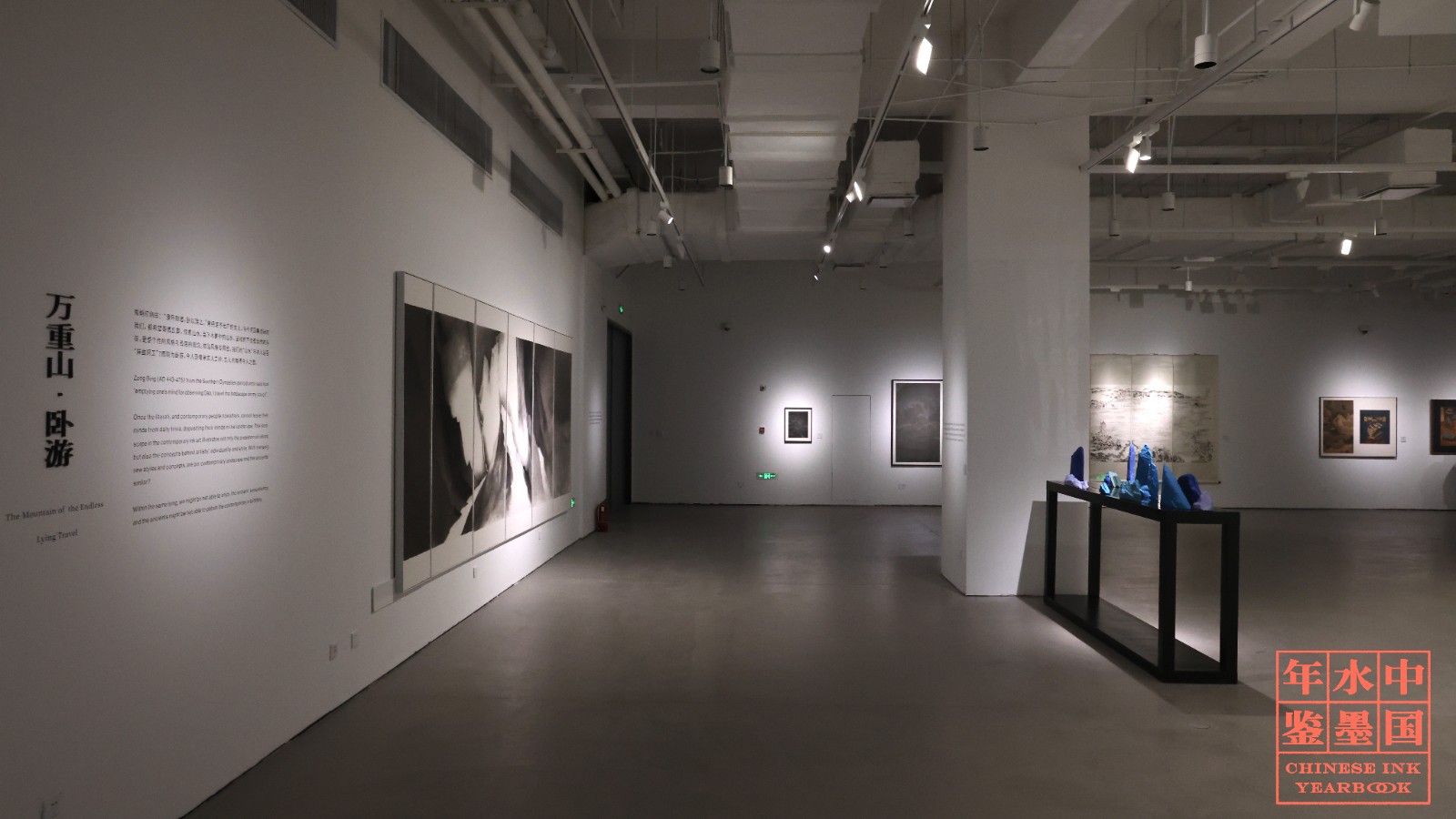 The theme of the first floor "Lying Tour" comes from Zong Bing in the Southern Dynasty: " Set one’s mind empty, and one can travel in a couch." The artist's works displayed on the first floor are based on the taste of traditional ink art. Based on this common ground, they explore uncharted water in terms of concepts, perspectives, and techniques. The following content will analyze and interpret the works one by one.
The theme of the first floor "Lying Tour" comes from Zong Bing in the Southern Dynasty: " Set one’s mind empty, and one can travel in a couch." The artist's works displayed on the first floor are based on the taste of traditional ink art. Based on this common ground, they explore uncharted water in terms of concepts, perspectives, and techniques. The following content will analyze and interpret the works one by one.
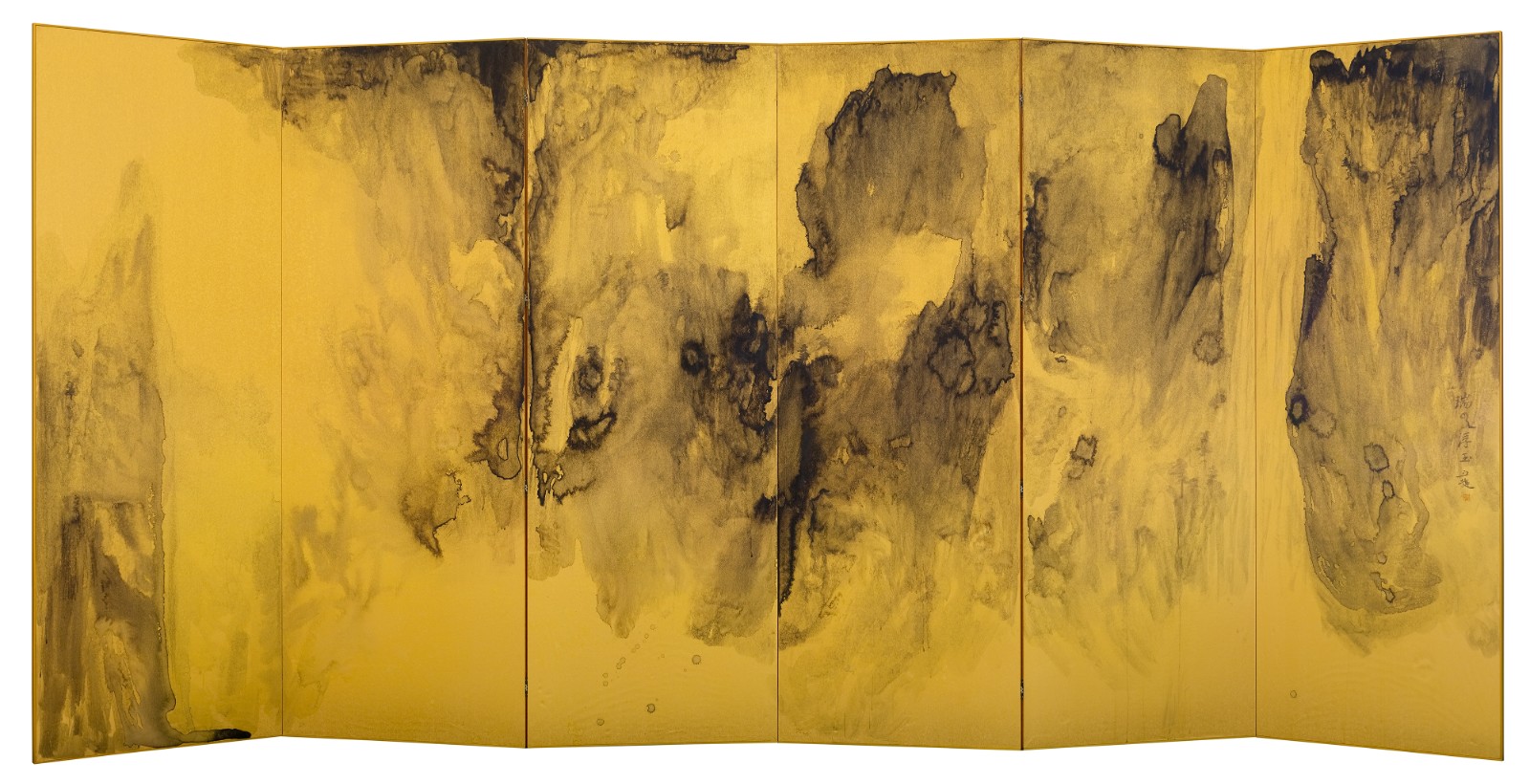 Qiu Ting's Floating Jades in Auspicious Clouds (2021) is a four-meter-long image painted on a golden screen. The artist made full use of the potential of splash-ink to express landscape and its surrounded ambience, and created the wonderful mountain forest ambience on the screen. The whole image is based on the landscape feature of Song and Yuan Dynasties, but it is freer and easier in modeling. The audience seems to be able to feel the free and easy intention of the artist in the creation of this work and the profound literati taste of vagueness accumulated over the years behind.
Qiu Ting's Floating Jades in Auspicious Clouds (2021) is a four-meter-long image painted on a golden screen. The artist made full use of the potential of splash-ink to express landscape and its surrounded ambience, and created the wonderful mountain forest ambience on the screen. The whole image is based on the landscape feature of Song and Yuan Dynasties, but it is freer and easier in modeling. The audience seems to be able to feel the free and easy intention of the artist in the creation of this work and the profound literati taste of vagueness accumulated over the years behind.  Shen Qin's Black and White·Mountain Series (2019) is one of the largest works in the exhibition. What is also striking is Shen Qin's distinctive creative strategy. As one of the iconic artists of Chinese contemporary ink art scene, Shen Qin explores a very subtle path between the restoration and innovation of ink art. Using very economic materials and methods, the work organically combines photography austerity, painterliness, and the taste and characteristics of ink painting in many aspects, while still establish in the field of traditional Chinese literati taste. The success of this creation is also reflected in its communicative nature -- even an observer who does not know much about the culture and history of ink painting would still be amazed by the ethereal images and lofty ambience created in Shen Qin's works.
Shen Qin's Black and White·Mountain Series (2019) is one of the largest works in the exhibition. What is also striking is Shen Qin's distinctive creative strategy. As one of the iconic artists of Chinese contemporary ink art scene, Shen Qin explores a very subtle path between the restoration and innovation of ink art. Using very economic materials and methods, the work organically combines photography austerity, painterliness, and the taste and characteristics of ink painting in many aspects, while still establish in the field of traditional Chinese literati taste. The success of this creation is also reflected in its communicative nature -- even an observer who does not know much about the culture and history of ink painting would still be amazed by the ethereal images and lofty ambience created in Shen Qin's works.
 Ding Guanjia's The Song of the Fishermen in the Spring River (2021) represents the creative path initiated by Xu Beihong. The color on paper method is used to create a similar form of water surface and reflective effect that is obviously different from the texture of oil painting, giving full play to the characteristics of delicate color and luster of ink mineral pigments.
Ding Guanjia's The Song of the Fishermen in the Spring River (2021) represents the creative path initiated by Xu Beihong. The color on paper method is used to create a similar form of water surface and reflective effect that is obviously different from the texture of oil painting, giving full play to the characteristics of delicate color and luster of ink mineral pigments.
 Lin Haizhong's The Magnificent Spectacle of Wu Mountain (2015) represents the contemporary face of Zhejiang school landscape. The artist skillfully uses the characteristics and changes of thick ink and light ink, line cun, surface cun, and dot cun brushstroke to depict the complex light and shadow reflected by the West Lake water and the beautiful scenery around it. The artist broke the narrative formula in the traditional landscape scroll, and innovatively followed the photographic logic in the composition, and used the trees in the foreground and the scenery in the distant to make a clever transition on the level of brushwork, and retained the taste in the traditional ink painting under the logic of contemporary images.
Lin Haizhong's The Magnificent Spectacle of Wu Mountain (2015) represents the contemporary face of Zhejiang school landscape. The artist skillfully uses the characteristics and changes of thick ink and light ink, line cun, surface cun, and dot cun brushstroke to depict the complex light and shadow reflected by the West Lake water and the beautiful scenery around it. The artist broke the narrative formula in the traditional landscape scroll, and innovatively followed the photographic logic in the composition, and used the trees in the foreground and the scenery in the distant to make a clever transition on the level of brushwork, and retained the taste in the traditional ink painting under the logic of contemporary images.

 Wang Shaoqiang's Pirecipitous Mountains 04 (2019) and Apex of the Amethyst Cloud 01 (2020) are two unique ink works on paper. The artist uses what may be a device similar to a hair dryer to dry the edges of large areas of water on the paper, allowing mineral pigments to settle on the paper in a brushstroke-free manner, and thus creating a very natural and delicate visual effect to show the changes of the ridge in the fog. On this basis, the artist placed clear symbols representing cities and landmarks in the GPS map on the image, quietly embedding contemporary elements into the picture of mountains. Its lethargy and unity of opposites linger long in the views’ mind.
Wang Shaoqiang's Pirecipitous Mountains 04 (2019) and Apex of the Amethyst Cloud 01 (2020) are two unique ink works on paper. The artist uses what may be a device similar to a hair dryer to dry the edges of large areas of water on the paper, allowing mineral pigments to settle on the paper in a brushstroke-free manner, and thus creating a very natural and delicate visual effect to show the changes of the ridge in the fog. On this basis, the artist placed clear symbols representing cities and landmarks in the GPS map on the image, quietly embedding contemporary elements into the picture of mountains. Its lethargy and unity of opposites linger long in the views’ mind.

Wang Tiande's work Behold a Boat beside the Cottage (2020-2021) consists with three materials in its form. On the far right of the picture is Li Yong's inscriptions Lushan Temple Monument from Tang Dynasty. On the left side of the picture is the content of Wang Tiande's painting. In this section on the left, the artist uses an original method to deal with lines and volume -- he uses the edge of incense burning to trace the rice paper, burning the surface and creating lines scattered like ink stains. The images constructed by these burning traces become the close and middle contents of the landscape, while the distant mountains at the top of the picture are depicted on the second layer of paper. A careful observation of the picture will find that the picture is actually composed of two layers of paper. The first layer of paper is composed of the incense mentioned above. On the second layer of paper, the artist depicted the whole picture with pen and ink, while the lower part of the picture was completely consistent with the burn marks of the first layer, and the upper part of the picture was covered under the first layer of paper, which was high and far.
Li Yong's inscriptions have such phrases as "to go into the cause with a cause, to go into tathagata with annihilation", and "Only the Zen master Huilong could trace his strength, exceed the cloud gate with his height, and avoid the net of the dust". The words in Li Yong's inscriptions not only show the vigorous knife carving method of Wei Bei's running script, but also are full of understanding and insightful comments on the Buddhist philosophy. In it, "to go into the cause with a cause, to go into tathagata with annihilation" have nothing to do with the contents of Wang Tiande's image, but it seems to imply that this layer of incense burning paper has the role of protection of the second layer of picture from the world in order to eliminate cause and effect. In addition, the rigidity of Li Yong's Wei tablet and the fragility of burning rice paper form a strong contrast. This comparison can remind the audience of the "RuRu" in Li Yong's passage, which is the profound complexity to human beings’ bodily nature of needs as an synthesis and a contradiction with Dharmakaya.
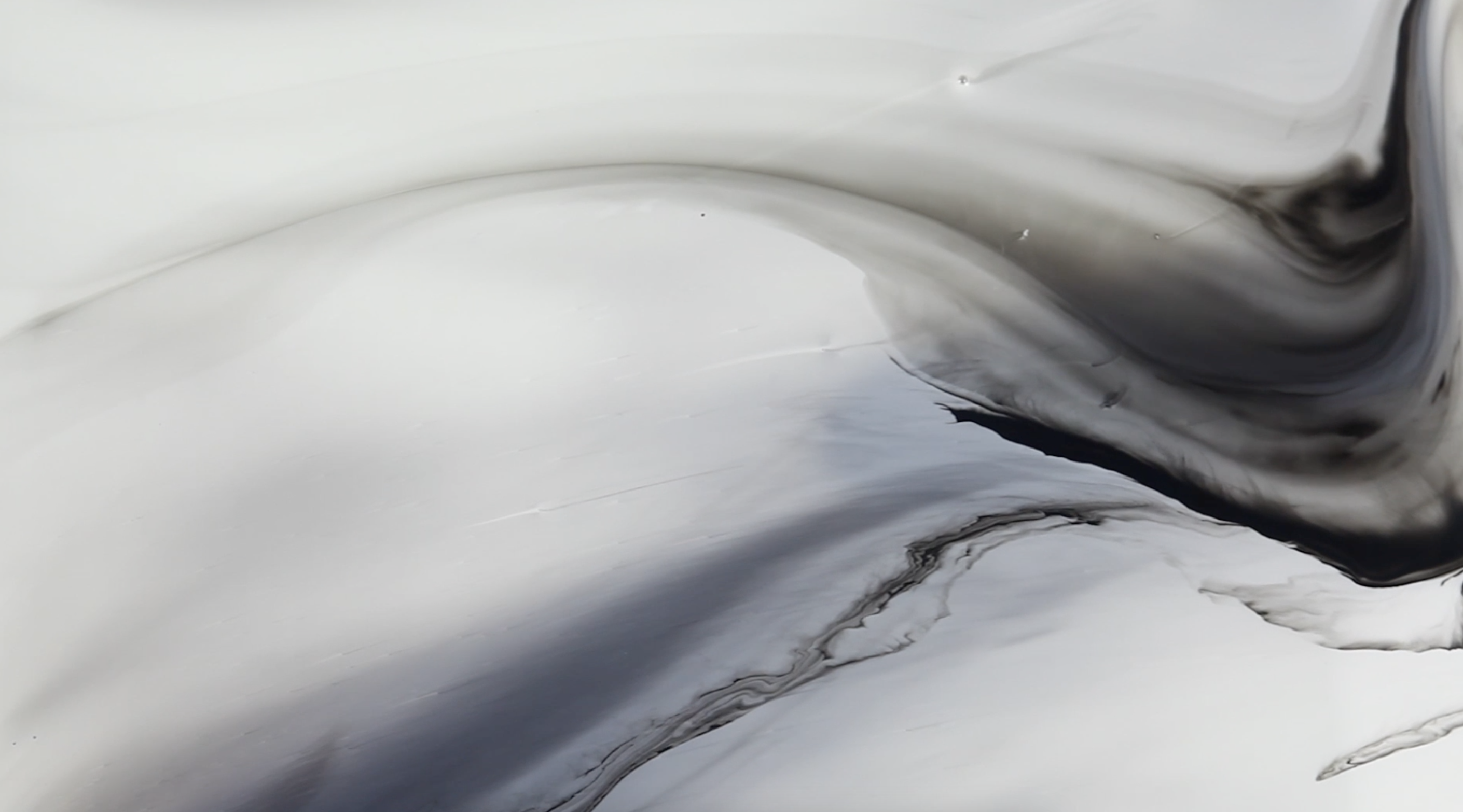 Wu Shaoying's work An Ink Drop (2015) is a 7-minute digital video work. The work creates an algorithm that becomes more and more complex over time by superimposing the visual effects produced by a drop of ink changing and spreading in space and time, which in turn embodies more and more complex visual effects in the image. Wu Shaoying's works show the rich vitality that ink art can present in the contemporary language of science and technology.
Wu Shaoying's work An Ink Drop (2015) is a 7-minute digital video work. The work creates an algorithm that becomes more and more complex over time by superimposing the visual effects produced by a drop of ink changing and spreading in space and time, which in turn embodies more and more complex visual effects in the image. Wu Shaoying's works show the rich vitality that ink art can present in the contemporary language of science and technology.
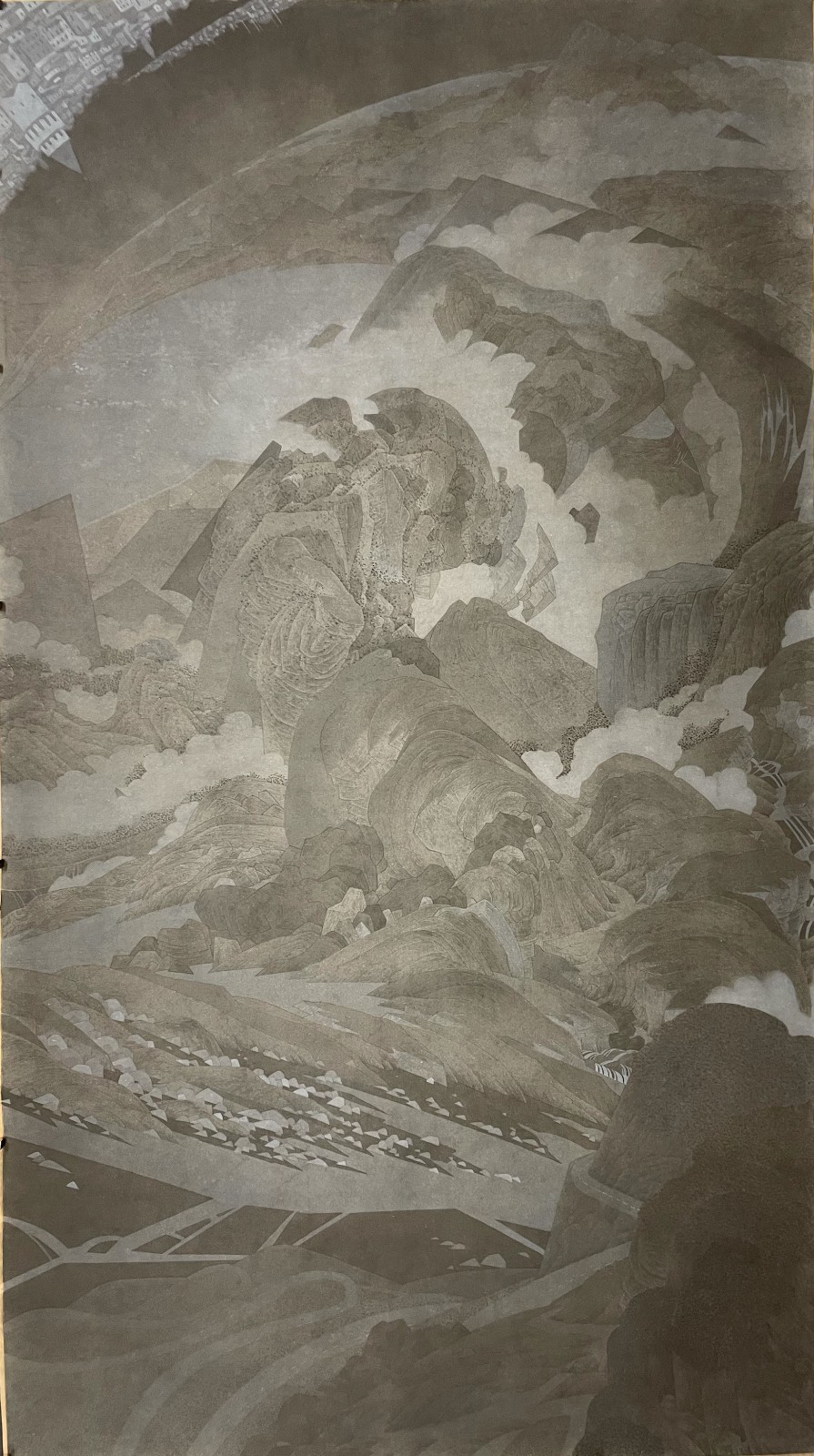
Xiao Xu's two works, High in the Clouds (2021) and Chasing the Rainbow (2021), are two impressive ink works on paper. The artist uses the traditional materials of ink painting, while he reconstructs the landscape in the literati tradition from the perspective of the virtual world and digitalization, thus creating a picture that is different from the tradition but vaguely retains the traditional taste. In his works, the placement program of near and medium vision in traditional ink works is retained, but the graphical method of depicting riverbanks, distant mountains, and cloud and fog gas has undergone a huge change.
 Xu Lei's Move the Mountain (2020) is one of the few installations in the exhibition. The work consists of a metal base and stones colored with mineral pigments. Blue stone is a common element in many of Xu Lei's works on paper, but this work takes out this iconic element of the artist, presents it in the form of installation, and explores the taste contained therein. Traditional Chinese landscape painting scrolls or handscrolls follow several patterns of near, medium and long-range composition and narrative models, such as Guo Xi's Three Yuan Method in the Northern Song Dynasty. This work by Xu Lei has exhausted all the possibilities of this narrative model of composition by matching and combining the colored stones representing the rocks on several tracks of the metal base, thus creating a deconstruction of the traditional landscape composition.
Xu Lei's Move the Mountain (2020) is one of the few installations in the exhibition. The work consists of a metal base and stones colored with mineral pigments. Blue stone is a common element in many of Xu Lei's works on paper, but this work takes out this iconic element of the artist, presents it in the form of installation, and explores the taste contained therein. Traditional Chinese landscape painting scrolls or handscrolls follow several patterns of near, medium and long-range composition and narrative models, such as Guo Xi's Three Yuan Method in the Northern Song Dynasty. This work by Xu Lei has exhausted all the possibilities of this narrative model of composition by matching and combining the colored stones representing the rocks on several tracks of the metal base, thus creating a deconstruction of the traditional landscape composition.
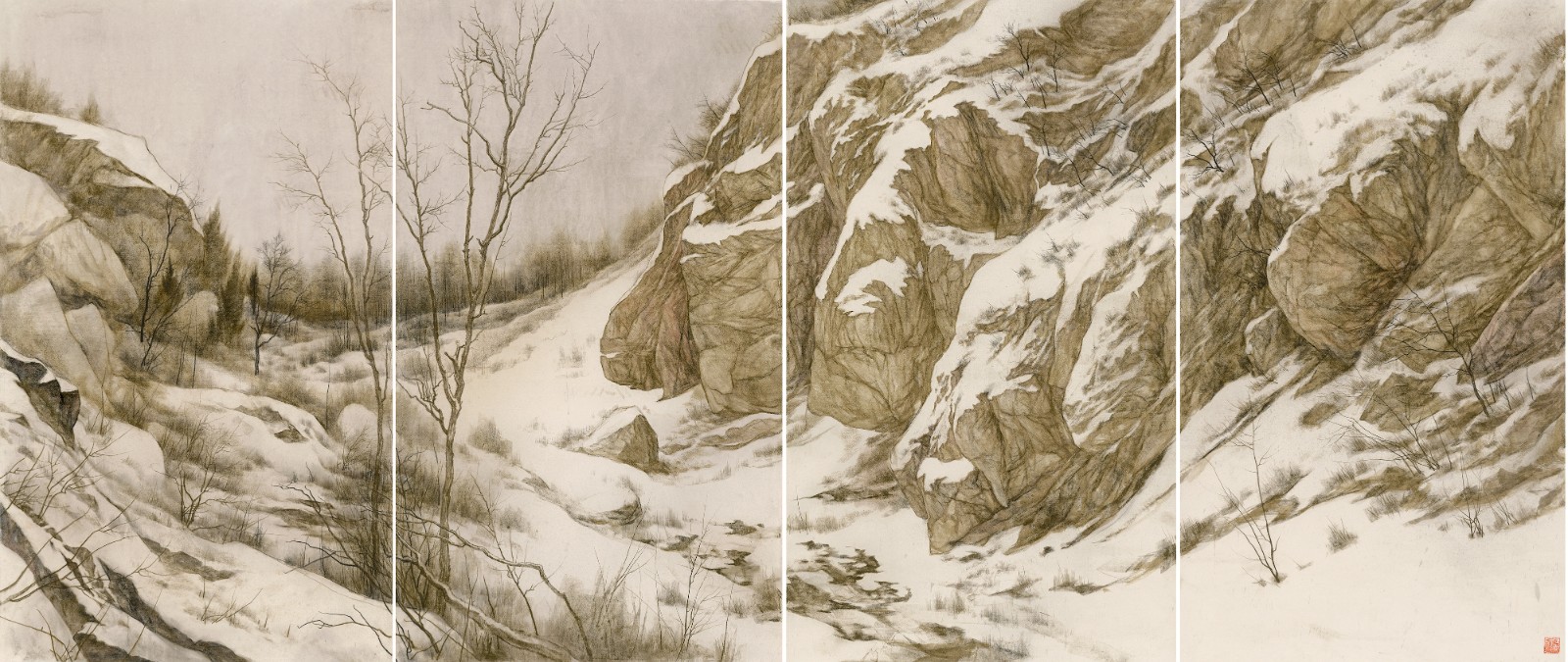 Francolin in the Sky (2021) by Dang Zhen is a work of 2 meters high and 5 meters wide. The work adopts the technique of paper color and the application of more mineral materials to complete the vivid depiction of a mountain and snow scene. The content of the picture looks placid and serene, but it reveals an elegance of antiquity.
Francolin in the Sky (2021) by Dang Zhen is a work of 2 meters high and 5 meters wide. The work adopts the technique of paper color and the application of more mineral materials to complete the vivid depiction of a mountain and snow scene. The content of the picture looks placid and serene, but it reveals an elegance of antiquity.
 Zhou Jingxin's Siming Villa Series (2017) consists of 10 pieces of ink and paper works. The works describe the well-arranged pavilions, courtyards water system and elegant gardens in Siming Villa. The composition of this work and the perspective of the artist's conception come from photography and sketch, but on this basis, the work contains a lot of elements of brush and language of ink. Through his profound control in ink’s changes on paper and his extraordinary spirit, the artist embodies the five groups of relations in the ink and wash tradition (line and surface, bone and flesh, light and thick, soft and firm, dry and wet) in his works, and creates pure spatial relations and object-image logic based on these five groups of relations.
Zhou Jingxin's Siming Villa Series (2017) consists of 10 pieces of ink and paper works. The works describe the well-arranged pavilions, courtyards water system and elegant gardens in Siming Villa. The composition of this work and the perspective of the artist's conception come from photography and sketch, but on this basis, the work contains a lot of elements of brush and language of ink. Through his profound control in ink’s changes on paper and his extraordinary spirit, the artist embodies the five groups of relations in the ink and wash tradition (line and surface, bone and flesh, light and thick, soft and firm, dry and wet) in his works, and creates pure spatial relations and object-image logic based on these five groups of relations.
 Wang He's two works, Spectacle in the Lens - Thousands of Miles of Jiangshan (2021) and TARDIS: Sunset Xishan Snow (2021), are two colored works on Silk. The artist constructs a visual narrative at the formal level by juxtaposing two images in one work. On one side, the artist uses skilled ink techniques to duplicate an ancient landscape painting, adding a graphic part based on the rationale of Western painting, such as a telephone booth or a magnifying glass. On the other side of the work, the narrative perspective of the image is placed in the elements drawn from the logic of western painting, while the elements constructed by traditional Chinese ink painting become a main theme of this part. The sharp contrast between Chinese and Western visual logic is juxtaposed in the way of spatial narration, producing a contemporary perspective; At the same time, the artist uses the way of color on silk to paint, and shows the open-mindedness of traditional Chinese techniques.
Wang He's two works, Spectacle in the Lens - Thousands of Miles of Jiangshan (2021) and TARDIS: Sunset Xishan Snow (2021), are two colored works on Silk. The artist constructs a visual narrative at the formal level by juxtaposing two images in one work. On one side, the artist uses skilled ink techniques to duplicate an ancient landscape painting, adding a graphic part based on the rationale of Western painting, such as a telephone booth or a magnifying glass. On the other side of the work, the narrative perspective of the image is placed in the elements drawn from the logic of western painting, while the elements constructed by traditional Chinese ink painting become a main theme of this part. The sharp contrast between Chinese and Western visual logic is juxtaposed in the way of spatial narration, producing a contemporary perspective; At the same time, the artist uses the way of color on silk to paint, and shows the open-mindedness of traditional Chinese techniques.
 The theme of the second floor is "Leaning on Parapet", this term comes from Song Dynasty poet Shi Wenxiang: "every day when I have spare time, I lean on parapet and watch birds soaring". The works displayed on the second-floor attempt to create a distance from the ancient Chinese cultural tradition in terms of taste, but above that, the basic techniques of creation generally follow the ancients. However, as the audience can see, these works are drastically different from the traditional trend in terms of concept, form, and perspective. However, the selection and consideration of tradition in these works are worth pondering and recalling.
The theme of the second floor is "Leaning on Parapet", this term comes from Song Dynasty poet Shi Wenxiang: "every day when I have spare time, I lean on parapet and watch birds soaring". The works displayed on the second-floor attempt to create a distance from the ancient Chinese cultural tradition in terms of taste, but above that, the basic techniques of creation generally follow the ancients. However, as the audience can see, these works are drastically different from the traditional trend in terms of concept, form, and perspective. However, the selection and consideration of tradition in these works are worth pondering and recalling.
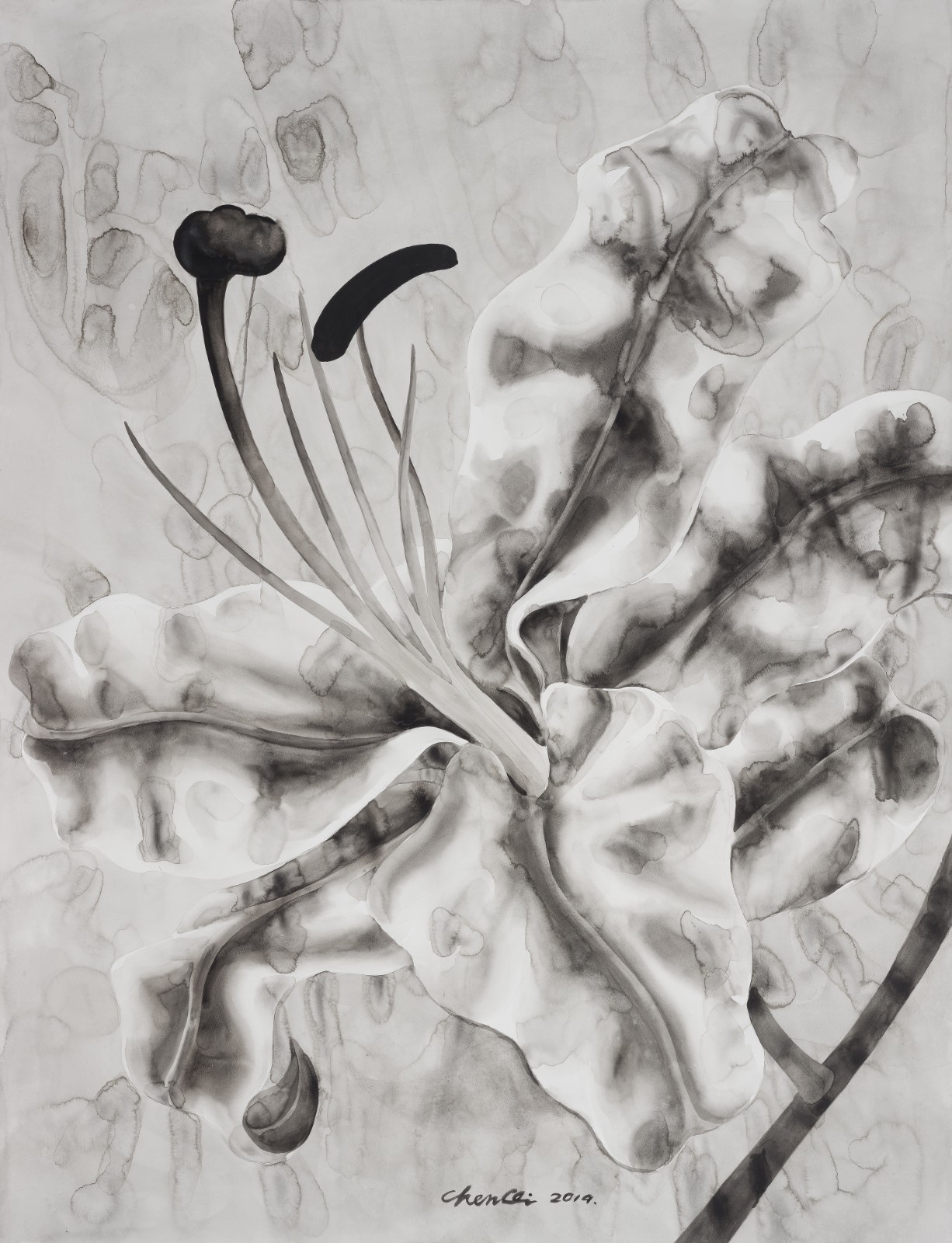 Chen Qi's works Lily No.2 and Lily No.4 (2019) use ink materials on paper to depict lilies in the logic of photography by accurately mastering the changes of shading between the shades of ink, and finally create a visual effect produced by silver sensitive photography. The delicate depiction of the edges of the petals in this work is impressive, and the indentation and protrusion of the petals are created by pressing the wet brush and light ink on the paper. The meticulous brushwork and the ink mark created by the freehand wet brush make up the amazing visual effect of both pieces.
Chen Qi's works Lily No.2 and Lily No.4 (2019) use ink materials on paper to depict lilies in the logic of photography by accurately mastering the changes of shading between the shades of ink, and finally create a visual effect produced by silver sensitive photography. The delicate depiction of the edges of the petals in this work is impressive, and the indentation and protrusion of the petals are created by pressing the wet brush and light ink on the paper. The meticulous brushwork and the ink mark created by the freehand wet brush make up the amazing visual effect of both pieces.
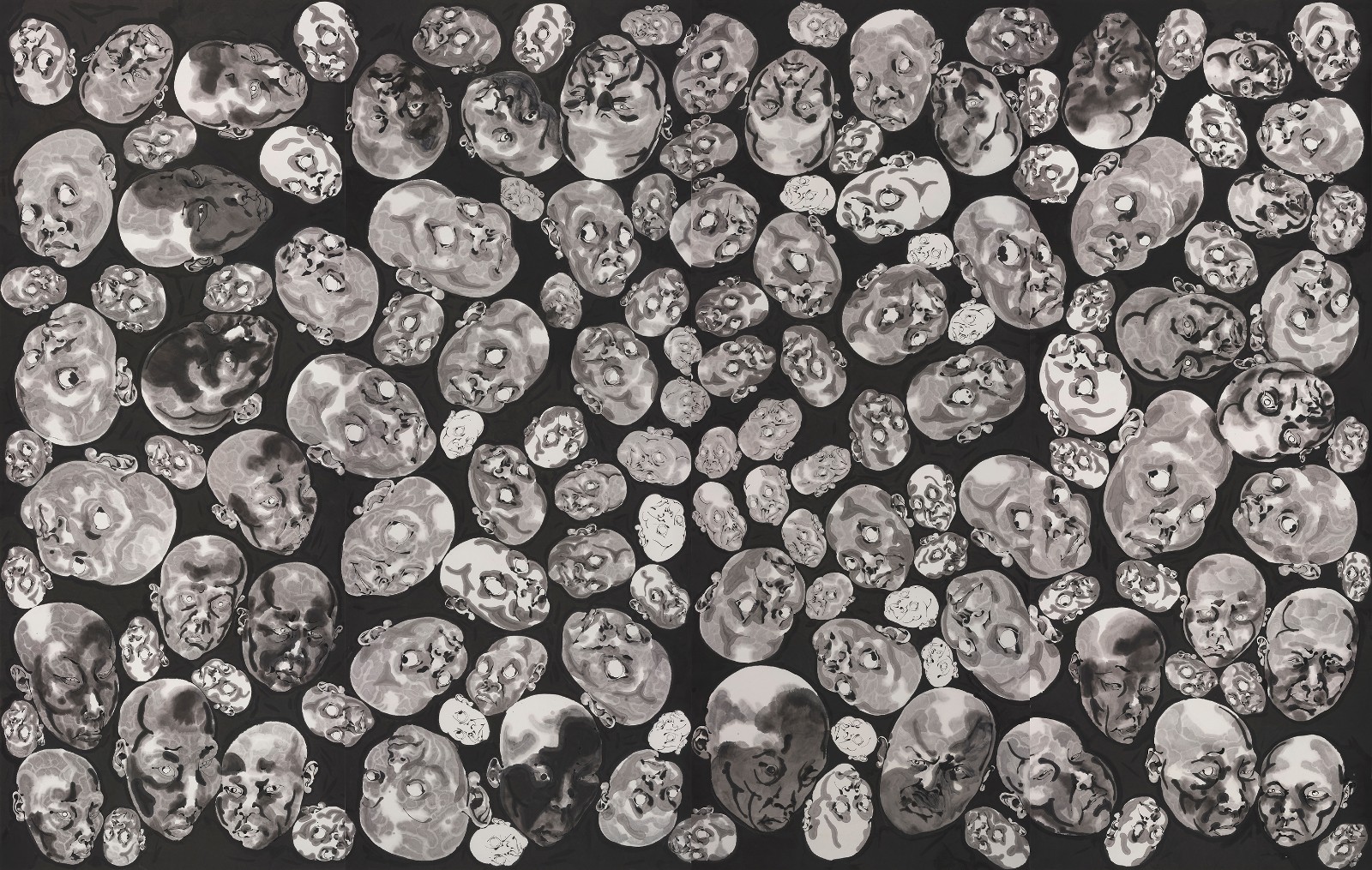 Fang Lijun's work 2020 (2020) is composed of four scrolls juxtaposed, occupying a whole exhibition wall in the exhibition hall with a width of 5 meters. This work consists of his distinguished faces on the picture, and the way he deals with the relationship between these faces had been done during the process of making. In this work, by controlling the ink painting shading effect as well as the modelling ability are fully mobilize, and build more than one hundred individual faces in the picture, the modelling of each face is unique.
Fang Lijun's work 2020 (2020) is composed of four scrolls juxtaposed, occupying a whole exhibition wall in the exhibition hall with a width of 5 meters. This work consists of his distinguished faces on the picture, and the way he deals with the relationship between these faces had been done during the process of making. In this work, by controlling the ink painting shading effect as well as the modelling ability are fully mobilize, and build more than one hundred individual faces in the picture, the modelling of each face is unique.
 Gao Qian's Branches on the Mountain No.3 (2018) is a juxtaposition with four hanging scrolls of meticulous brush tree painting. In addition to the elegant and fresh traditional humanistic interest formed between the branches and flowers (cherry blossom or peach blossom) in the picture itself, it continues the tradition of expressing one's ambition through things passed down from Zhao Mengjian's Narcissus (1279), and fully demonstrates elegance in the composition through the form of the trend of branches.
Gao Qian's Branches on the Mountain No.3 (2018) is a juxtaposition with four hanging scrolls of meticulous brush tree painting. In addition to the elegant and fresh traditional humanistic interest formed between the branches and flowers (cherry blossom or peach blossom) in the picture itself, it continues the tradition of expressing one's ambition through things passed down from Zhao Mengjian's Narcissus (1279), and fully demonstrates elegance in the composition through the form of the trend of branches.
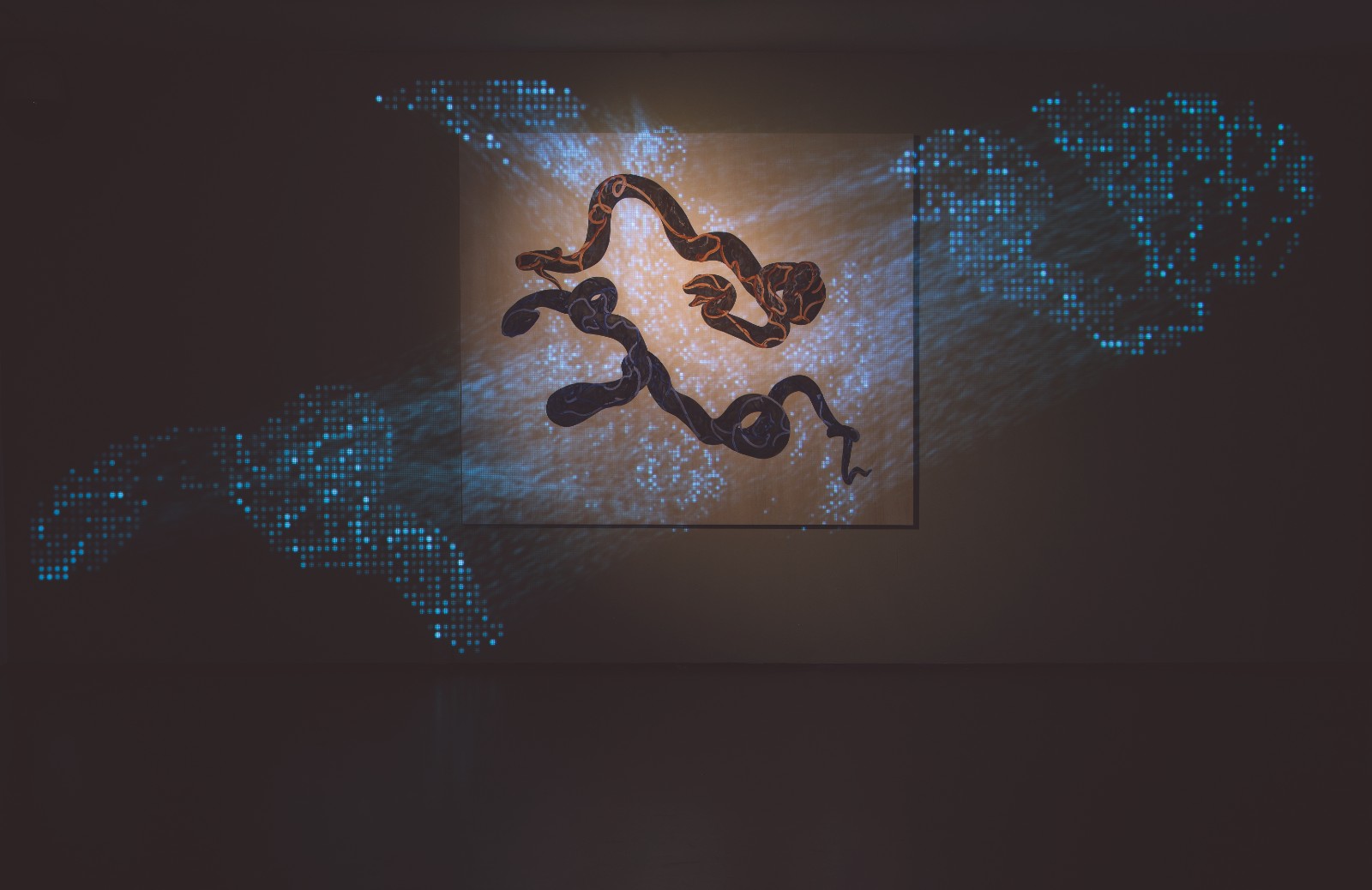 Kang Chunhui's work Root of All Life·Confrontation (2016-2017) is a special work, because the artist does not touch on the context of literati ink painting tradition in her creation. Instead, she builds a pictorial, symbolic and stylistic context system based on her collation and study of Kizil murals with a large number of elements involved in the eastern and western mythological themes, as well as the symbolic and metaphysical contemplation. This work is a emblematic result of this scheme. The artist uses color ink on paper to depict two pythons in Laocoon and His Sons, a sculpture of Hellenistic period, and used digital projection to project the images of Laocoon and Sons on the python bodies to form overlapping. Given that Laocoon and His Sons is a work about man's inability to escape the shackles of fate, this overlap between projection image and paper image creates a new perspective to re-exam both the form and media.
Kang Chunhui's work Root of All Life·Confrontation (2016-2017) is a special work, because the artist does not touch on the context of literati ink painting tradition in her creation. Instead, she builds a pictorial, symbolic and stylistic context system based on her collation and study of Kizil murals with a large number of elements involved in the eastern and western mythological themes, as well as the symbolic and metaphysical contemplation. This work is a emblematic result of this scheme. The artist uses color ink on paper to depict two pythons in Laocoon and His Sons, a sculpture of Hellenistic period, and used digital projection to project the images of Laocoon and Sons on the python bodies to form overlapping. Given that Laocoon and His Sons is a work about man's inability to escape the shackles of fate, this overlap between projection image and paper image creates a new perspective to re-exam both the form and media.
 Li Jin's work The Long-lived (2020) is drawn on a ten-meter-long hand scroll. Li Jin's technique language and operation mode completely follow the path of traditional Chinese literati ink painting. However, between the shapes of these plants, the image of people has quietly changed. The characters under Li Jin's brush are vulgar and libidinal, but this does not make the viewer feel any unpleasantness. On the contrary, under the humanistic style and ink play, the libidinal characters contain a fresh and contemporary touch. Li Jin's inscriptions, postscripts and strokes are quite relaxed, and the quality of the lines is remarkably high. All these elements produce a rare masterpiece in contemporary ink painting.
Li Jin's work The Long-lived (2020) is drawn on a ten-meter-long hand scroll. Li Jin's technique language and operation mode completely follow the path of traditional Chinese literati ink painting. However, between the shapes of these plants, the image of people has quietly changed. The characters under Li Jin's brush are vulgar and libidinal, but this does not make the viewer feel any unpleasantness. On the contrary, under the humanistic style and ink play, the libidinal characters contain a fresh and contemporary touch. Li Jin's inscriptions, postscripts and strokes are quite relaxed, and the quality of the lines is remarkably high. All these elements produce a rare masterpiece in contemporary ink painting.
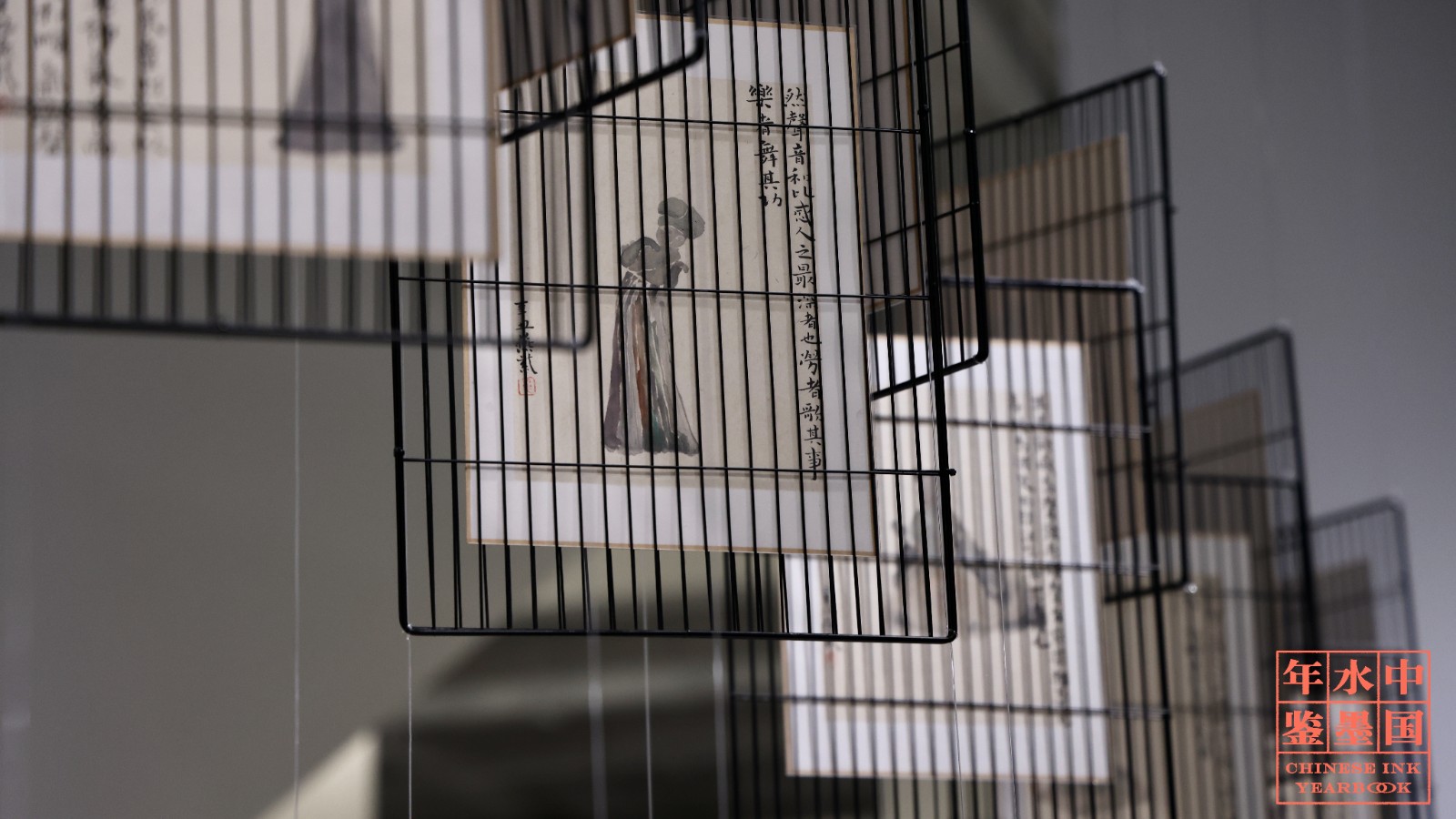 Zhang Yanzi's work Delightful Series (2021) is a 12-piece installation consisting of colored ink on paper and iron fences. The artist uses mineral pigments to depict twelve figures from Han Dynasty terracotta or decoration. Each figure is unique, but dance, playing, and artisan related movements are shared among them. It is worth noting that the artist's depiction of these images does not involve lines at all, which is quite different from the "stroke first, then fill in the color" in most paper color works. The artist uses a wet brush and light ink, and details, such as the fingers playing the lute, highlight her precise control of the brush and ink. The work was created during the period when the artist was isolated after returning to Beijing from the United States in 2021, which can be reflected in the dual meaning of isolation and protection with iron fence in the work.
Zhang Yanzi's work Delightful Series (2021) is a 12-piece installation consisting of colored ink on paper and iron fences. The artist uses mineral pigments to depict twelve figures from Han Dynasty terracotta or decoration. Each figure is unique, but dance, playing, and artisan related movements are shared among them. It is worth noting that the artist's depiction of these images does not involve lines at all, which is quite different from the "stroke first, then fill in the color" in most paper color works. The artist uses a wet brush and light ink, and details, such as the fingers playing the lute, highlight her precise control of the brush and ink. The work was created during the period when the artist was isolated after returning to Beijing from the United States in 2021, which can be reflected in the dual meaning of isolation and protection with iron fence in the work.
 Wang Dongling's The Tao Te Ching from Lao Zi (2019) is conducted on a 3-meter-long screen. Wang Dongling uses cinnabar instead of ink as writing material, and unlike the calligraphic masters in history, Wang Dongling's wild grass is extremely wild. It seems that in order to pursue the sense of fluency and continuity, the spatial relationship and narrative relationship between characters are intentionally ignored to the lower layer and almost disappear. The destruction of the balance in the tradition is a strategy of modernism. Wang Dongling's excellency lies in that, on the one hand, he adopts this strategy of modernism, and on the other hand, he preserves the context and tradition of Chinese culture in the execution.
Wang Dongling's The Tao Te Ching from Lao Zi (2019) is conducted on a 3-meter-long screen. Wang Dongling uses cinnabar instead of ink as writing material, and unlike the calligraphic masters in history, Wang Dongling's wild grass is extremely wild. It seems that in order to pursue the sense of fluency and continuity, the spatial relationship and narrative relationship between characters are intentionally ignored to the lower layer and almost disappear. The destruction of the balance in the tradition is a strategy of modernism. Wang Dongling's excellency lies in that, on the one hand, he adopts this strategy of modernism, and on the other hand, he preserves the context and tradition of Chinese culture in the execution.
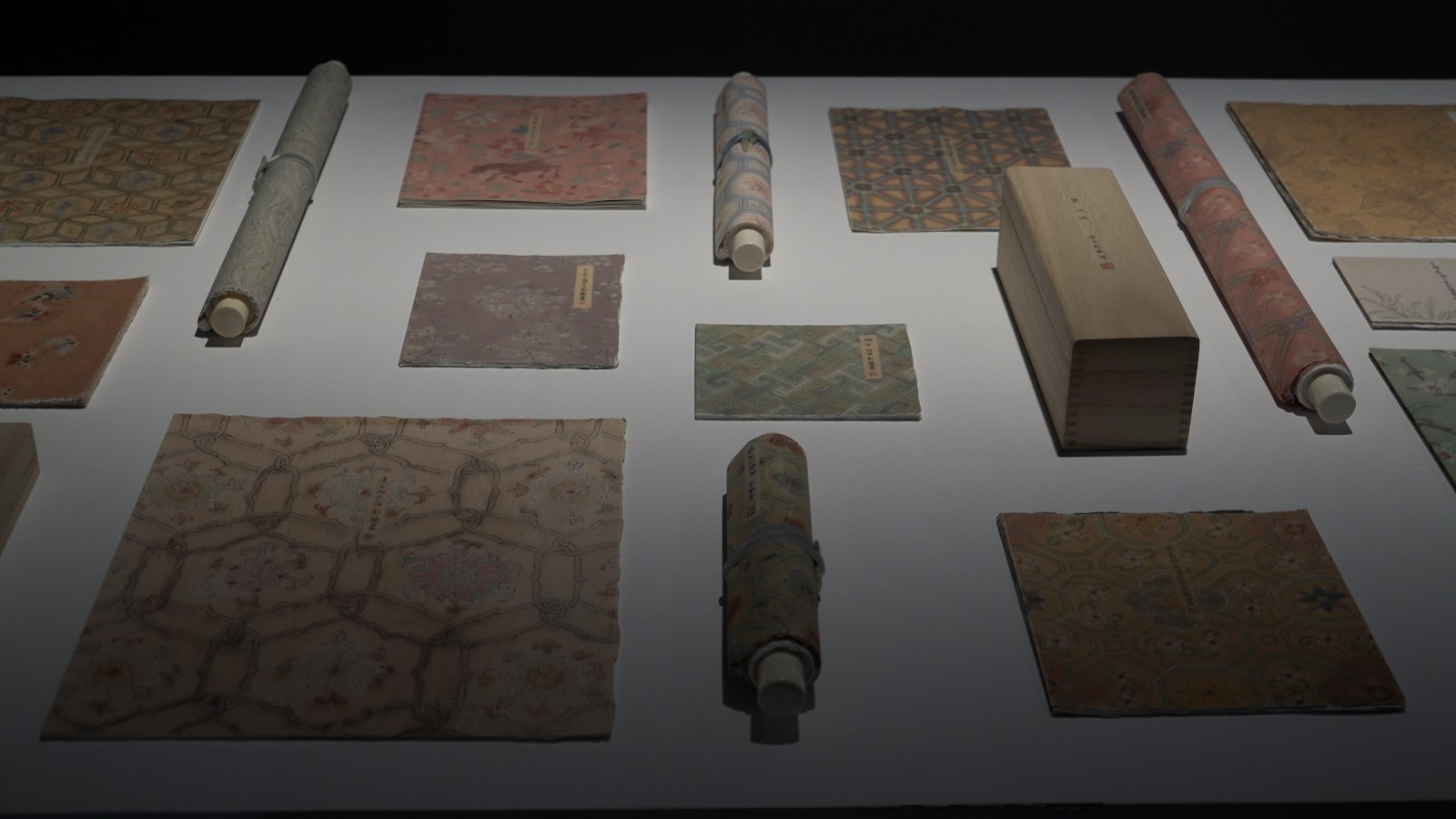 Peng Wei's Distant Letters (2012-2017) is a set of scrolls, sketchbooks, and wooden boxes in which the scrolls are packaged. In this work, the artist's creation focuses on the presentation of the carrier in the traditional humanistic context, as well as the decoration and description of the less important part of the carrier. This work touches on a very core issue in the development of ink painting, that is, how should we treat the literati tradition and social context of ink art at present while we are fully realized that the former literati social context had been cease to existed-- the way these works are presented and the way the audience views them are all drastically different than what they used to be. These problems, such as the social function of the work, put the ink works that follow the tradition of the context in an awkward and even untenable position. The subtlety of Peng Wei's work lies in her stance and attitude towards the contemporary absence of traditional literati context.
Peng Wei's Distant Letters (2012-2017) is a set of scrolls, sketchbooks, and wooden boxes in which the scrolls are packaged. In this work, the artist's creation focuses on the presentation of the carrier in the traditional humanistic context, as well as the decoration and description of the less important part of the carrier. This work touches on a very core issue in the development of ink painting, that is, how should we treat the literati tradition and social context of ink art at present while we are fully realized that the former literati social context had been cease to existed-- the way these works are presented and the way the audience views them are all drastically different than what they used to be. These problems, such as the social function of the work, put the ink works that follow the tradition of the context in an awkward and even untenable position. The subtlety of Peng Wei's work lies in her stance and attitude towards the contemporary absence of traditional literati context.
 Two of Ma Lingli's works, Eternity. Daytime (2018) and Lying Peacefully with the Sea (2018), construct a series of installations in the form of silk paintings. The work is based on high-quality meticulous color as the image, creating an illusion space composed of forest swaying in the wind; At the same time, the relationship between objects constructed in the exhibition space by mobilizing the frame as a display object creates the fracture of the image in the objecthood and the continuation of the visuality. With these two works, the artist shows the exploration of the physical space of the form and concept constructed by the young artist based on ink and paper.
Two of Ma Lingli's works, Eternity. Daytime (2018) and Lying Peacefully with the Sea (2018), construct a series of installations in the form of silk paintings. The work is based on high-quality meticulous color as the image, creating an illusion space composed of forest swaying in the wind; At the same time, the relationship between objects constructed in the exhibition space by mobilizing the frame as a display object creates the fracture of the image in the objecthood and the continuation of the visuality. With these two works, the artist shows the exploration of the physical space of the form and concept constructed by the young artist based on ink and paper.
 Peng Jian's two works Harmony (2020) and A Cup Filled with Three Balls (2020) are colored ink on paper with a very special style and concept. The artist uses rice paper as a medium for painting, but the content of the painting completely abandons the style relates to all the cultural contexts in the Chinese tradition of ink art. Peng Jian's painting style is similar to Mondrian's analytical color gamut, but the artist does not attempt to deconstruct a specific object image; instead, he tries to reconstruct the composition logic of near, medium and long range in traditional Chinese landscape painting with the sense of volume generated by gamut and lines on the premise of building a balanced relationship between one gamut and another.
Peng Jian's two works Harmony (2020) and A Cup Filled with Three Balls (2020) are colored ink on paper with a very special style and concept. The artist uses rice paper as a medium for painting, but the content of the painting completely abandons the style relates to all the cultural contexts in the Chinese tradition of ink art. Peng Jian's painting style is similar to Mondrian's analytical color gamut, but the artist does not attempt to deconstruct a specific object image; instead, he tries to reconstruct the composition logic of near, medium and long range in traditional Chinese landscape painting with the sense of volume generated by gamut and lines on the premise of building a balanced relationship between one gamut and another.
 Xie Tienzhuo's two works Oasis (2021) and A New Route (2021) are two easel works painted on rice paper using colored ink on paper. There are strong elements of neo-expressionism and surrealism in the style of the work. The artist constructs many complex figures and symbols in a concrete illusion space, trying to reflect some chaotic contemporary mental state and cultural context. It is unique in contemporary ink painting to construct such a complex image and structure originally belonging to oil painting through the medium of paper color ink painting.
Xie Tienzhuo's two works Oasis (2021) and A New Route (2021) are two easel works painted on rice paper using colored ink on paper. There are strong elements of neo-expressionism and surrealism in the style of the work. The artist constructs many complex figures and symbols in a concrete illusion space, trying to reflect some chaotic contemporary mental state and cultural context. It is unique in contemporary ink painting to construct such a complex image and structure originally belonging to oil painting through the medium of paper color ink painting.
 Zeng Jianyong's series of works Do-not-want-to-return (2020), Pine Stone (2019), Listening Water (2019), and Mountain Steam (2019) are a group of very interesting paper color works, among which Pine Stone, Listening Water, and Mountain Steam are space installation works based on paper color. The spatial narrative constructed by images and the physical narrative constructed by works in the real physical space run through Zeng Jianyong's works and constitute the main elements of taste. The artist uses fine brushwork on paper to depict gardens, landscapes, and figures, as well as the "space" that divides these visual elements. On the other hand, the exhibition builds a real space to display the installations in Pine Stone, Listening Water, and Mountain Steam. These devices look like "mountains" in dry landscapes but are actually devices crimped with images depicted on paper. In this light-hearted and humorous way, the work explores the interpenetration of images and physical space.
Zeng Jianyong's series of works Do-not-want-to-return (2020), Pine Stone (2019), Listening Water (2019), and Mountain Steam (2019) are a group of very interesting paper color works, among which Pine Stone, Listening Water, and Mountain Steam are space installation works based on paper color. The spatial narrative constructed by images and the physical narrative constructed by works in the real physical space run through Zeng Jianyong's works and constitute the main elements of taste. The artist uses fine brushwork on paper to depict gardens, landscapes, and figures, as well as the "space" that divides these visual elements. On the other hand, the exhibition builds a real space to display the installations in Pine Stone, Listening Water, and Mountain Steam. These devices look like "mountains" in dry landscapes but are actually devices crimped with images depicted on paper. In this light-hearted and humorous way, the work explores the interpenetration of images and physical space.
Text by Zi Lin.
Courtesy of the organizer.
References:
方聞(Wen C. Fong) - 人物 - 中央美術(shù)學(xué)院藝術(shù)資訊網(wǎng)-CAFA Art Info
Ink Art: Past as Present in Contemporary China (publishersweekly.com)
Ink Art: Past as Present in Contemporary China, by Maxwell K. Hearn. New York: The Metropolitan Museum of Art, 2013. 208 pp. US$50.00 (hardcover).: The China Journal: Vol 73 (uchicago.edu)
賈方舟:當(dāng)代水墨與它面對(duì)的國(guó)際文化環(huán)境_藝術(shù)中國(guó) (china.cn)
2020年度“中國(guó)水墨年鑒”全面啟動(dòng) - 資訊 - 新聞 - 中央美術(shù)學(xué)院藝術(shù)資訊網(wǎng)-CAFA Art Info
重磅|年度水墨大展“萬重山——中國(guó)水墨年鑒”開展_湃客_澎湃新聞-The Paper
探討中國(guó)水墨藝術(shù)的當(dāng)下發(fā)展:“中國(guó)水墨年鑒”論壇活動(dòng)月開啟 - 講座 - 新聞 - 中央美術(shù)學(xué)院藝術(shù)資訊網(wǎng)-CAFA Art Info




























